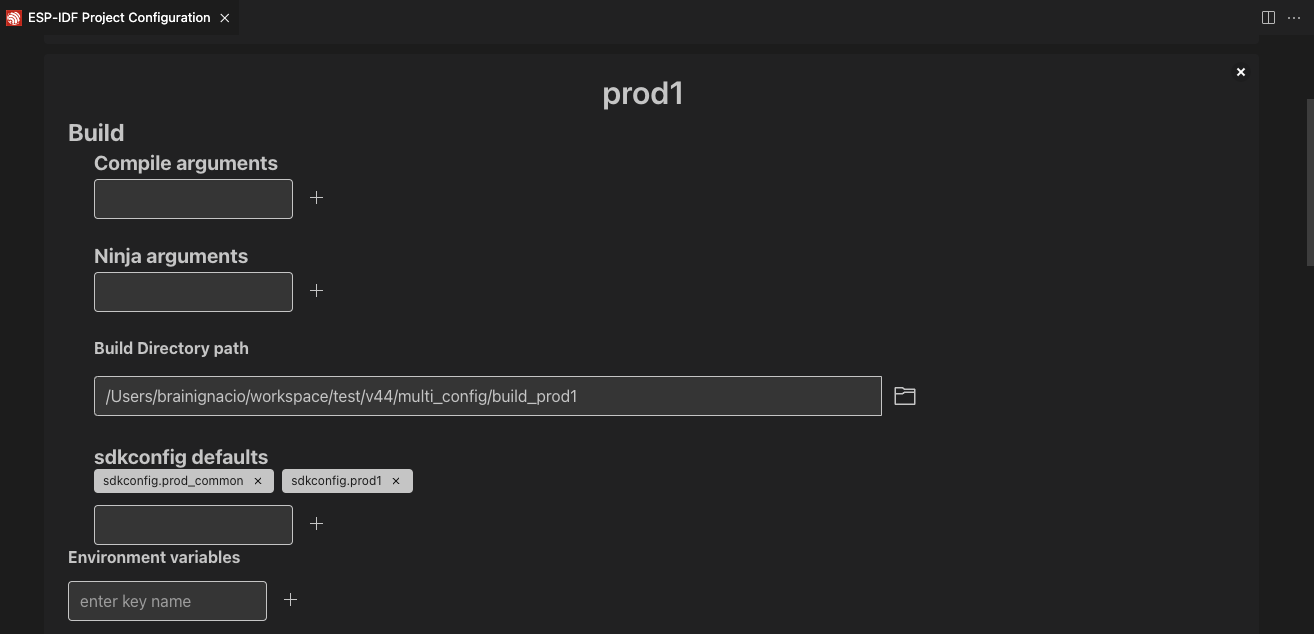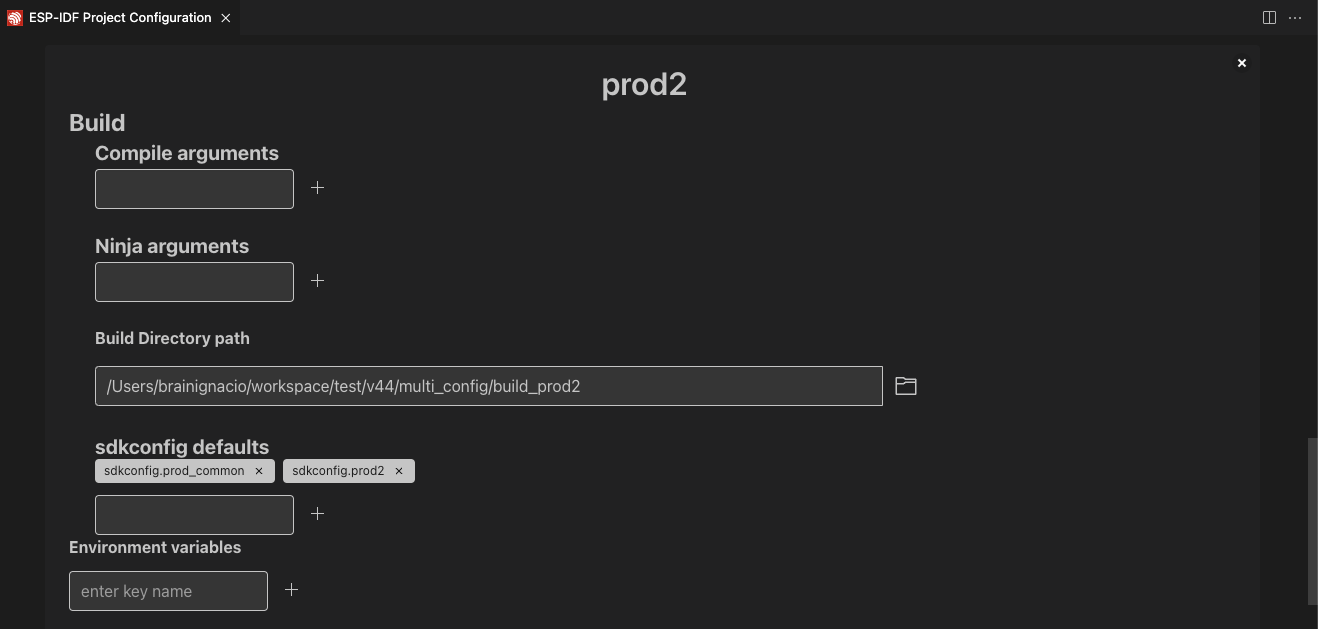Working with Multiple Projects
For big projects, a user will typically have one or more projects to build, flash or monitor. The ESP-IDF Extension follows the Visual Studio Code Workspace File Schema to identify all projects folders inside the current workspace (which would be the root folder). Please take a look at Creating User and Workspace Settings.
Configuration settings are overriden as:
Workspace folder configuration settings in
${workspaceFolder}/.vscode/settings.jsonWorkspace configuration settings defined in the workspace’s
<name>.code-workspacefile as shown below.User settings defined in
Windows
%APPDATA%\Code\User\settings.jsonMacOS
$HOME/Library/Application Support/Code/User/settings.jsonLinux
$HOME/.config/Code/User/settings.json
This extension uses the idf.saveScope configuration setting to determine where to save configuration settings in features such as the Setup Wizard. You can modify this using the ESP-IDF: Select where to Save Configuration Settings command.
You can select the current project by clicking the ESP-IDF Current Project Item in the Visual Studio Code Status bar or by pressing F1 and typing ESP-IDF: Pick a Workspace Folder which will determine the folder where to obtain the ESP-IDF Settings such as current device USB port, ESP-IDF path, etc.
Projects folders (Known in vscode as workspace folders) and workspace level settings are defined in some <name>.code-workspace file such as:
{
"folders": [
{
"path": "./project1"
},
{
"path": "./project2"
}
],
"settings": {
"idf.port": "/dev/ttyUSB1",
"idf.espIdfPath": "${env:HOME}/esp/esp-idf"
}
}
Settings in the root folder’s .code-workspace can be used when your ESP-IDF Current Project directory doesn’t contain a .vscode/settings.json file.
If you want to open a project with multiple subprojects in Visual Studio Code, click Menu File > Open Workspace which will open a window to select the .code-workspace file describing your workspace.
You can either manually create this .code-workspace file and define all sub folders (projects) or when you click Menu File > Save Workspace as… which doesn’t automatically add any folder inside the current directory.
You can add a folder to the workspace when you click Menu File > Add Folder to Workspace….
Note
You still need to manually select the corresponding debug configuration in the Debug tab of your current workspace folder. There is a project directory suffix on each debug configuration.
Example
Consider the following multiple projects directory tree example:
---> /my-projects-root
------> /my-projects-root/project1
------> /my-projects-root/project2
------------> /my-projects-root/project2/.vscode/settings.json
and my-ws.code-workspace:
{
"folders": [
{
"path": "/my-projects-root/project1"
},
{
"path": "/my-projects-root/project2"
}
],
"settings": {
"idf.port": "/dev/ttyUSB1",
"idf.espIdfPath": "${env:HOME}/esp/esp-idf"
}
}
If you open Visual Studio Code, click Menu File > Open Workspace and open
my-ws.code-workspaceyou will see just the folders defined in this workspace (/my-projects-root/project1and/my-projects-root/project2). - Forproject1, Visual Studio Code will use the settings frommy-ws.code-workspacefirst then other required settings from the User Settings. - Forproject2, Visual Studio Code will use those settings from/my-projects-root/project2/.vscode/settings.jsonfirst, then all required (and not found) settings frommy-ws.code-workspaceand finally in the Visual Studio Code User settings.If you just open the
/my-projects-rootor/my-projects-root/project1directory Visual Studio Code will use the User Settings. - If you just open the/my-projects-root/project2directory Visual Studio Code will use the/my-projects-root/project2/.vscode/settings.jsonthen other required settings from the User Settings.
Note
If you open /my-projects-root, any of the sub projects will not be recognized as Workspace Folders, you need to add them to my-ws.code-workspace (manually or using File > Add Folder to Workspace…) and open this workspace as specified before.
Use multiple build configuration in the same workspace folder
Use the ESP-IDF CMake Multiple Configuration Example to follow this tutorial.
Use the ESP-IDF: Open Project Configuration and create two configurations profiles: prod1 and prod2 and sdkconfig.prod_common;sdkconfig.prod1 and sdkconfig.prod_common;sdkconfig.prod2 on the sdkconfig defaults field as shown below:



After creating each profile and the configuration settings for each profile, click the Save button and use the ESP-IDF: Select Project Configuration command to choose the configuration to override extension configuration settings.

After a configuration profile is selected, the selected profile will be shown in the status bar as shown before.

Now use the ESP-IDF: Build your Project to build the project for prod1 and prod2. You can observe binaries generated for each profiles in the path defined in each profile as before. You can use ESP-IDF: Select Project Configuration command to switch between configurations.
Use the ESP-IDF: Open Project Configuration command to modify, add or delete the configuration profiles. If you want to stop using these profile, just delete all configuration profiles.
Multiple ESP-IDF Versions
You can use multiple ESP-IDF versions, one for each ESP-IDF project by explicitly defining your configuration settings in your current project directory .vscode/settings.json.
Set the
idf.saveScopeto WorkspaceFolder with the ESP-IDF: Select where to Save Configuration Settings command or directly in the.vscode/settings.jsonof desired project opened in Visual Studio Code.Configure the extension as described in Install ESP-IDF and Tools documentation.
Make sure to delete any previous build directory since a different ESP-IDF version would not work if there is any cache of previous build.
Repeat from 1) on any project you would like to use a different version from the global user settings.
Using Multiple Build Configuration Manually
As shown in the ESP-IDF CMake Multiple Configuration example you can use multiple build directories and multiple sdkconfig defaults files to produce different production output.
In this extension you can define the build directory with the idf.buildPath (idf.buildPathWin fo Windows) configuration setting and the list of sdkconfig default files with idf.sdkconfigDefaults configuration. The value of these settings will be using by the extension build command.
Say you want to make product 1:
you have sdkconfig files
sdkconfig.prod_commonandsdkconfig.prod1and you want the resulting firmware to be generated in<your-project>/build_prod1wherebuild_prod1is the name of the custom build folder.Add these settings in
<your-project>/.vscode/settings.json:
{
// ...
"idf.buildPath": "${workspaceFolder}/build_prod1",
"idf.sdkconfigDefaults": ["sdkconfig.prod_common", "sdkconfig.prod1"]
// ...
}
Build your project using the ESP-IDF: Build your Project command.
Your resulting files will be generated in
<your-project>/build_prod1and the sdkconfig being used by the SDK Configuration Editor will be<your-project>/build_prod1/sdkconfig.Change values in 2) for different products and configurations.